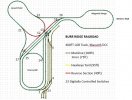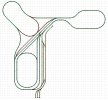Finally got all the track down and wired up and am now in need of some assistance to debug strange behavior. I'm using LGB turnouts - 1600 on the mainline and 1200 in the yard. A short is happening on the yard breaker whenever I "close" the #2 switch. It only appears with this switch, the position of the other 6 turnouts do not seem to make a difference. If the switches are all-live I'm stumped to understand why this would be happening when closing the turnout to send the train straight (closure rail touches the 'red' rail). I tried replacing the entire switch, but the issue remains. I also tried putting isolating clamps "above" this switch, but that also has no effect.
After tracing all the wires surprisingly there appears to be continuity between the yard and mainline on the 'red' rail, which originates from 2 PSX breakers for those zones despite having isolating clamps at the two ends of the yard. The black leg does not, as expected. Red is the innermost rail in my layout for each rail pair. I have the power inputs for 2 PSX circuit breakers daisy-chained together as described to do in the manual when using multiple units and zones. I see continuity between the 2 'red' outputs from both PSX breakers when they either daisy-chained or split from a terminal block from the CS.
I'm also having some trouble with the PSX-AR on the inner reverse loop. A short is occurring over the double slip in some directions. Right now I have isolation joiners on the 2 legs to the south and on the northeast side of the double slip.
Here is the schematic I've put together showing the feeders, isolation joints, and power zones.
The mainline has 4 feeders, and the yard and inner loop both have 2 each.
View attachment 266219
Any ideas or feedback would be greatly appreciated!









